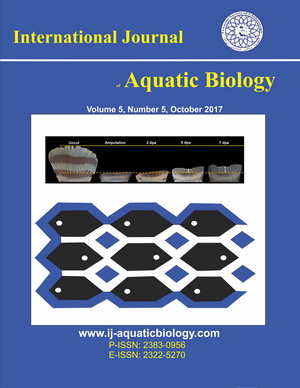New insights on the seasonal trend of Goniodoridella picoensis (Paz-Sedano, Ortigosa & Pola, 2017) along the central-eastern coast of Sicily: A possible warning of its expansion and establishment in the Mediterranean Sea?
Downloads
Goniodoridella picoensis is a nudibranch species originally described from Pico Island (Azores, Atlantic Ocean). After its description, the reports of this species suddenly increased in a short timeframe, leading to two main hypotheses: one that it is native to the entire Atlanto-Mediterranean region, the other that it is a non-indigenous species that entered the Mediterranean from the Atlantic Ocean. The present study explored the seasonal trend of G. picoensis along the central-eastern coast of Sicily to understand whether this species is non-indigenous and its possible pattern of spread and establishment in that area. To carry out this research, a photographic visual census activity through scuba dives was performed in four sites with different anthropogenic pressures (Ognina, Santa Maria La Scala, Scalo Pennisi, and Acque Fredde) throughout three years (from 2021 to 2023). A similar seasonal trend was found in all the sites. The number of individuals of this species started to increase in the autumn months, maintained or rose during the spring, and throughout the summer months underwent a sharp decline. The negative correlation between the temperature and the number of specimens also evidenced this seasonal trend. Indeed, even if this species can tolerate a wide temperature range, it would seem to prefer lower temperatures, like those of the winter-spring months, when there is a higher availability of food supply. The sites with the highest number of specimens were Scalo Pennisi and Acque Fredde, probably both because of the higher natural conditions compared to the other sites and because of the influence of tidal currents of the Strait of Messina and the upwelling currents of the Ionian Sea, which might act as a veliger conveyor belt. Overall, from 2021 to 2023, an increase in assemblages’ size was observed in all the sites. Moreover, the breeding activity was documented between 2022 and 2023. Considering the above, G. picoensis is most likely a non-indigenous species coming from the Atlantic Ocean. The collected data reflect that this species has settled in these study areas in the last years and indicate that G. picoensis is establishing stable populations there. Indeed, the probability that this species is Atlanto-Mediterranean and has been so far overlooked seems unlikely, not only due to the intense research in the Mediterranean area but also for the conspicuousness of this species.
Downloads
Ben Rais Lasram F., Tomasini J.A., Romdhane M.S., Do Chi T., Mouillot D. (2008). Historical colonization of the Mediterranean Sea by Atlantic fishes: Do biological traits matter? Hydrobiologia, 607: 51-62.
Catra M., Giaccone T., Giardina S., Nicastro A. (2006). Il patrimonio naturale marino bentonico della Timpa di Acireale (Catania). Bollettino dell’Accademia Gioenia di Scienze Naturali, 39: 129-158.
Coma R., Ribes M., Gili J.M., Zabala M. (2000). Seasonality in coastal benthic ecosystems. Trends in Ecology and Evolution, 15: 448-453.
Crocetta F., Al Mabruk S., Azzurro E., Bakiu R., Bariche M., Batjakas I., Bejaoui T., Ben Souissi J., Cauchi J., Corsini-Foka M., Deidun A., Evans J., Galdies J., Ghanem R., Kampouris T., Katsanevakis S., Kondylatos G., Lipej L., Lombardo A., Marletta G., Mejdani E., Nikolidakis S., Ovalis P., Rabaoui L., Ragkousis M., Rogelja M., Sakr J., Savva I., Tanduo V., Turan C., Uyan A., Zenetos A. (2021). New Alien Mediterranean Biodiversity Records (November 2021). Mediterranean Marine Science, 22: 724-746.
Fantin M., Ciriaco S., Faresi L., Scrigner C., Vecchi L., Trkov D., Lirej L. (2023). First evidence of the presence of Okenia picoensis Paz-Sedano, Ortigosa & Pola, 2017 (Gastropoda: Nudibranchia) in the Adriatic Sea. Annales Series Historia Naturalis, 33: 271-276.
Furfaro G., De Matteo S., Mariottini P., Giacobbe S. (2018). Ecological notes of the alien species Godiva quadricolor (Gastropoda: Nudibranchia) occurring in Faro Lake (Italy). Journal of Natural History, 52: 645-657.
Gerovasileiou V., Akyol O., Al-Hosne Z., Alshikh Rasheed R., Ataç E., Bello G., ?etkovi? I., Corsini Foka M., Crocetta F., Denitto F., Guidetti P., Gül B., Insacco G., Jimenez C., Licchelli C., Lipej L., Lombardo A., Mancini E., Marletta G., Michailidis N., Peši? A., Poursanidis D., Refes W., Sahraoui H., Thasitis I., Tiralongo F., Tosuno?lu Z., Trkov D., Vazzana A., Zava B. (2020). New records of rare species in the Mediterranean Sea (May 2020). Mediterranean Marine Science, 0: 340-359.
Lombardo A., Marletta G., Leonardi G. (2020). Seasonality of Edmundsella pedata (Montagu, 1816) (Nudibranchia Flabellinidae) along the Ionian coasts of Sicily (Central Mediterranean Sea). Biodiversity Journal, 11: 631-638.
Lombardo A., Marletta G. (2019a). Presence of the alien species Godiva quadricolor (Barnard, 1927) (Gastropoda Nudibranchia Facelinidae) along the coast of eastern Sicily. Biodiversity Journal, 10: 147-150.
Lombardo A., Marletta G. (2019b). A new Atlantic immigrant in the Mediterranean Sea: Pleurobranchus wirtzi Ortea, Moro et Caballer, 2014 (Gastropoda Pleurobranchida). Biodiversity Journal, 10: 275-278.
Lombardo A., Marletta G. (2020a). New records of Biuve fulvipunctata (Baba, 1938) (Gastropoda Cephalaspidea) and Taringa tritorquis (Ortea, Perez & Llera, 1982) (Gastropoda Nudibranchia). Biodiversity Journal, 11: 587-591.
Lombardo A., Marletta G. (2020b). First record of Aporodoris millegrana (Alder et Hancock, 1854) (Gastropoda Heterobranchia Nudibranchia) in the Ionian Sea, central Mediterranean Sea. Biodiversity Journal, 11: 875-878.
Lombardo A., Marletta G. (2021a). New evidence of the ongoing expansion of Okenia picoensis Paz-Sedano, Ortigosa & Pola, 2017 (Gastropoda: Nudibranchia) in the Central-Eastern Mediterranean. Annales Series Historia Naturalis, 30: 165-174.
Lombardo A., Marletta G. (2021b). Seasonality of the Alien Lamprohaminoea ovalis (Pease, 1868) (Gastropoda: Cephalaspidea) along the Central-eastern Coasts of Sicily, Central Mediterranean Sea. Acta Zoologica Bulgarica, 73: 621-628.
Lombardo A., Marletta G. (2023a). Diversity of the marine Heterobranchia fauna at the island of Pantelleria, Sicily Channel, Mediterranean Sea: First contribution. Acta Zoologica Bulgarica, 75: 37-48.
Lombardo A., Marletta G. (2023b). The marine Heterobranchia (Mollusca: Gastropoda) fauna of the Aeolian archipelago (Tyrrhenian Sea). First contribution: Lipari and Vulcano. International Journal of Aquatic Biology, 11: 288-300.
Lombardo A., Marletta G. (2023c). Seasonal trend of nudibranchs (Gastropoda, Heterobranchia) along the central-eastern coast of Sicily (Mediterranean Sea). Journal of Black Sea/Mediterranean Environment, 29: 1-24.
Marletta G., Lombardo A. (2023). Population dynamics of Ericaria zosteroides (Ochrophyta, Fucales) in the central Mediterranean. Mediterranean Botany, 44: e79885.
Mollo E., Gavagnin M., Carbone M., Castelluccio F., Pozone F., Roussis V., Templado J., Ghiselin M.T., Cimino G. (2008). Factors promoting marine invasions: a chemoecological approach. Proceedings of the National Academy of Sciences, 105: 4582-4586.
Orfanidis S., Alvito A., Azzurro E., Badreddine A., Ben Souissi J., Chamorro C., Crocetta F., Dalyan C., Forti? A., Galanti L., Geyran K., Ghanem R., Goruppi A., Grech D., Katsanevakis S., Madrenas E., Mastrototaro F., Montesanto F., Pavi?i? M., Pica D., Pola L., Pontes M., Ragkousis M., Rosso A., Sánchez-Tocino L., Tierno De Figueroa J.M., Tiralongo F., Tirelli V., Tsioli S., Tunçer S., Vrdoljak D., Vuletin V., Zaouali J., Zenetos A. (2021). New alien Mediterranean biodiversity records (March 2021). Mediterranean Marine Science, 22: 180-198.
Rudman W.B. (2004). Further species of the opisthobranch genus Okenia (Nudibranchia: Goniodorididae) from the Indo-West Pacific. Zootaxa, 695: 1-70.
Paz-Sedano S., Moles J., Smirnoff D., Gosliner T.M., Pola M. (2024). A combined phylogenetic strategy illuminates the evolution of Goniodorididae nudibranchs (Mollusca, Gastropoda, Heterobranchia). Molecular Phylogenetics and Evolution, 192: 107990.
Paz-Sedano S., Ortigosa D., Pola M. (2017). A new Okenia Menke, 1830 from the Azores Islands, Portugal (Mollusca, Nudibranchia, Goniodorididae). Spixiana, 40:13-22.
Picton B., Morrow C. (2023). Nudibranchs of Britain, Ireland and Northwest Europe. Princeton University Press, Oxford. 360 p.
Pola M., Paz-Sedano S., Macali A., Minchin D., Marchini A., Vitale F., Licchelli C., Crocetta F. (2019). What is really out there? Review of the genus Okenia Menke, 1830 (Nudibranchia: Goniodorididae) in the Mediterranean Sea with description of two new species. PLoS ONE, 14: e0215037.
Rizgalla J., Fitori A., Doneddu M., Trainito E. (2023). First record of the non-indigenous Mollusca Okenia pellucida Burn, 1967 (Nudibranchia: Goniodorididae) in the Mediterranean basin. Bollettino Malacologico, 59: 54-58.
Sciuto F., Sanfilippo R., Alongi G., Catra M., Serio D., Bejaoui S., Leonardi R., Viola A., Rosso A. (2017). First data on ostracods and foraminifera living in Cystoseira communities in western Ionian Sea (southern Italy, Mediterranean Sea). Mediterranean Marine Science, 18: 393-405.
Sorgente R., Olita A., Oddo P., Fazioli L., Ribotti A. (2011). Numerical simulation and decomposition of kinetic energy in the Central Mediterranean: insight on mesoscale circulation and energy conversion. Ocean Science, 7: 503-519.
Trainito E., Migliore V., Doneddu M. (2022). How many seas must a nudibranch sail? Okenia picoensis (Mollusca: Nudibranchia: Goniodorididae) conquering the Mediterranean. Studia Marina, 35: 15-25.
Copyright (c) 2024 International Journal of Aquatic Biology

This work is licensed under a Creative Commons Attribution 4.0 International License.








